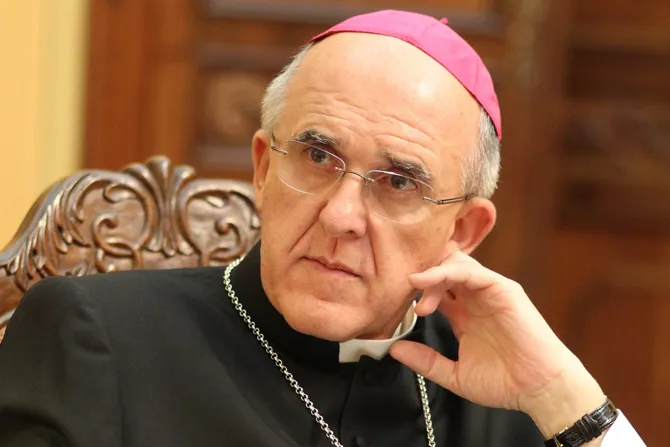Madrid, Spain, Aug 29, 2014 / 15:27 pm
The appointment of Carlos Osoro Sierra as the new Archbishop of Madrid is another step forward in the renewal of the ranks of the Spanish bishops that at the same time raises expectations for Curia reform.
The Vatican announced Aug. 28 that Archbishop Osoro, who headed the Valencia archdiocese, would go to Madrid to take the place of Cardinal Antonio Rouco Varela, who resigned due to reaching the age limit for archbishops set by Church law.
Cardinal Antonio Canizares Llovera, who has served in the Vatican as prefect of the Congregation for Divine Worship since 2008, will take Archbishop Osoro's place as the new Archbishop of Valencia.
Known for his liturgical principles, Cardinal Canizares, 69, has long been rumored to be willing to return to Spain.
He was considered eligible for two "top positions": that of Madrid and that of Barcelona.
Canizares would have been a difficult choice for the archbishop of Barcelona, being without Catalan origins. Madrid would have appeared to be the destination for the prefect who wished to return to Spain.
The Spanish bishops' conference has already started the process of renewal. During its plenary assembly held Nov. 18-22 last year, the Spanish bishops' conference had named its new board. Monsignor Antonio Gil y Tamayo, who served as Holy See Press Office assistant during the 2013 sede vacante period, was elected general secretary and spokesperson of the conference.
The Spanish bishops gathered for another plenary assembly March 11-14 and elected a new president of the conference: Archbishop Ricardo Blazquez Perez of Valladolid.
In that same assembly, Carlos Osoro Sierra, then-Archbishop of Valencia, was elected deputy president of the conference.
It was the moment when the star of Archbishop Osoro rose.
Ordained a priest in 1973, Osoro became Bishop of Orenese in 1997, Archbishop of Oviedo in 2002 and Archbishop of Valencia in 2009. He is now 69 years old.
Known for preaching about a "Church that goes out," the archbishop is not considered a progressive. He is considered very orthodox in faith. According to a Spanish source, he will give the Archdiocese of Madrid his human touch, yet preserve the orthodoxy of its teaching.
In a letter sent to the Archdiocese of Madrid after his appointment was disclosed, Archbishop Osoro addressed priests, members of religious congregations, the laity and young people of his new diocese. He said he asks "the Lord to make me be at your side, according to His will that goes very much beyond any human will."
Archbishop Osoro and Msgr. Gil y Tamayo are considered very close, and together they are called to head the renewal of the ranks of the Spanish bishops.
According to the Spanish daily Religion Digital, this new cycle replaces a course which has lasted for 24 years, during which Cardinal Rouco Varela of Madrid acted as a true "Spanish deputy Pope" under both Popes John Paul II and Benedict XVI. Cardinal Varela had earlier advocated as his successor his auxiliary Bishop Fidel Herraéz.
One difficulty that could have arisen if Cardinal Canizares had been appointed Archbishop of Madrid is the fact that he holds no post in the Spanish Bishops Conference.
The Spanish bishops also felt the risk of a new "Rouco Varela case" in which one archbishop could head an influential archdiocese for many years, explained a source from within the Spanish Bishops' Conference who spoke on condition of anonymity.
"Cardinal Canizares is 69 and had already worked in the Roman Curia. If he had been appointed in Madrid, he would have remained in that post at least until his retirement at 75, thus creating a new eventual center of power," the source told CNA Aug. 28.
This is the reason that the Spanish bishops promoted the new course, backing the appointment of Archbishop Osoro to Madrid.
The new vacancy at the Archdiocese of Valencia allows Cardinal Canizares to return to his home diocese. He hails from Utiel, a small town in Valencia province.
The cardinal's successor as prefect of Divine Worship has not been announced, which means that Pope Francis has not made the decision yet.
It is possible that the appointment of the new prefect will not be made soon.
The Congregation for the Divine Worship is one of the Vatican dicasteries that could be included in the streamlining of the Roman Curia that is now under discussion.
One proposal is to make a combined congregation from the Congregation for Divine Worship and the Congregation for the Causes of Saints. That the proposal is being processed is indicated by the fact that Cardinal Angelo Amato, prefect of the Congregation for the Causes of Saints, has been only confirmed "ad interim" by Pope Francis, yet he has passed the age of retirement and his successor has not yet been appointed.
Cardinal Canizares' successor at the Congregation for Divine Worship could be disclosed after the coming meeting of the council of cardinals advising Pope Francis. That meeting is scheduled for Sep. 15-17.


